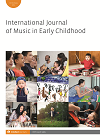
Full text loading...

In this article, I present a comprehensive analysis of peer-reviewed research articles published in English between 2000 and 2017 regarding active music making in early childhood (EC) educational settings. My specific research questions were: who was making music? Who else was present? What did the children and other persons do? In what kinds of educational settings did the music making take place? How did the researchers frame and design their studies, and how did they collect data? What did the researcher(s) seek to understand? What did the researchers find? The results of this review challenge the EC music education profession to support every child’s right to a musical childhood by telling the whole story, communicating across places and communities of practice and understanding teaching and learning as contextual, varied and nuanced.

Article metrics loading...

Full text loading...
References


Data & Media loading...

Publication Date:
https://doi.org/10.1386/ijmec.14.1.35_1 Published content will be available immediately after check-out or when it is released in case of a pre-order. Please make sure to be logged in to see all available purchase options.